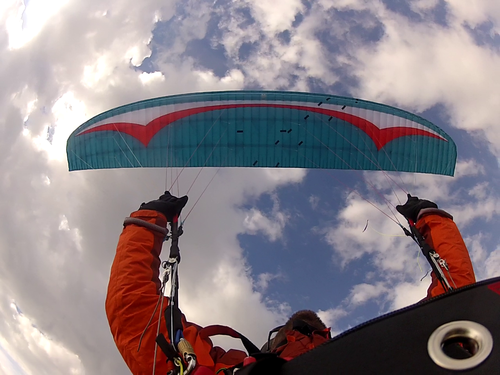Carrera S |
|||||||||||||||||||||||||||||||||||||||||||||||||||||||||||||||||||||||||||||||||||||||||||||||||||||||||||||||||||||||||||||||||||||


|
|||||||||||||||||||||||||||||||||||||||||||||||||||||||||||||||||||||||||||||||||||||||||||||||||||||||||||||||||||||||||||||||||||||
Instability rating |
|||||||||||||||||||||||||||||||||||||||||||||||||||||||||||||||||||||||||||||||||||||||||||||||||||||||||||||||||||||||||||||||||||||
|
|||||||||||||||||||||||||||||||||||||||||||||||||||||||||||||||||||||||||||||||||||||||||||||||||||||||||||||||||||||||||||||||||||||
Glider characteristics |
|||||||||||||||||||||||||||||||||||||||||||||||||||||||||||||||||||||||||||||||||||||||||||||||||||||||||||||||||||||||||||||||||||||
|
Launch preparations: difficult
launch characteristics: dynamic, climbs constantly, no guidance necessary, good feedback during inflation, overshoots, pronounced braking required, control check simple, low takeoff speed
asymmetric collapse: canopy colllapses at high angle to leading edge, high dynamics, total course change 180-270°, (3), fast course change rate, high forward pitching 75-90°, (5), high height loss 40-49 m, (3), high sink velocity 20-24 m/s, (3), collapse on opposite wingtip with course change >90°, (5), with cravat, (5), G-Force 2,5- 2,9 G, (2)
Frontal collapse: canopy collapses with high total collapse aera, high pitch backwards >60°, marked pitch forwards 45-60°, high dynamics, course change <90°, (2), recovery usually immediate, usually symmetric recovery, advanced pilot action required, (5), immediate return to normal airspeed, with tendency to cravat, (4), high height loss 40-49 m, (3), low sink velocity 10-14 m/s, (1)
Spiral dives: very rapid sink velocity increase, extremely high G-Force > 5,0 G, (5), Sink velocity after 720° > 22 m/s, (5), Extremely high maximum sink velocity >25 m/s, (5), sink velocity increase > 10 m/s on brake release, (5), Stable spiral dive, (5)
B-Stall: normal force required, moderate pitch backwards 15-30°, marked pitch forwards 30-45°, stable sink phase, no tendency to deform, immediate return to normal airspeed, 6-8 m/s, height loss on recovery < 20 m
big ears: simple initiation, unsteady flight phase, wingtips flatter markedly, pilot action required, Vsink unaccelerated 3-3,5 m/s, Vsink accelerated 4-4,5 m/s, Vaccelerated 5-8 km/h faster than trimspeed
Steering behaviour: dynamic, 75 cm brake travel range, very noticable brake pressure increasse, Late stall point, easily identifiable |
|||||||||||||||||||||||||||||||||||||||||||||||||||||||||||||||||||||||||||||||||||||||||||||||||||||||||||||||||||||||||||||||||||||
Notes |
|||||||||||||||||||||||||||||||||||||||||||||||||||||||||||||||||||||||||||||||||||||||||||||||||||||||||||||||||||||||||||||||||||||
|
en: Launch preparations: Gin Gliders Carrera has a complete set of unsheathed lines, which require appropriate attention when sorting, particularly as the upper gallery lines tend to tangle somewhat. The risers are uncomplicated but the outer A-line does not have a separate extension. Launch characteristic: Gin's Carrera needs to be layed out in a pronounced crescent, otherwise the wingtips have a tendency to overtake the canopy middle during inflation, which results in a horseshoe. With a gentle impulse the canopy climbs quickly and homogeneously without delay. There is no noticeable slowing before the zenith. Care needs to be taken that the start impulse is not too severe, otherwise marked brake input (or severe on steep slopes) is required to prevent the canopy from overshooting. Asymmetric Collapse: The Gin Carrera LTF-B classification with regard to collapses is difficult to comprehend. The canopy begins to turn dynamically, but not to the high degree of the Atis 4. The following dive forward angular speeds (in degrees per second) are then unusually high. Trim speed collapses demonstrated these dynamic reactions, and were often accompanied by collapses on the opposite wingtip and cravats. Test pilot input was then required to prevent a follow-on spiral dive due to the cravat. Interestingly, accelerated collapses were somewhat less challenging and had fewer cravat problems. The glider requires a pilot with the skills necessary to immediately minimize the follow-on reactions of a large asymmetric collapse. Front collapses: Gin's Carrera was the most challenging glider tested here. The shark-nose leading edge suddenly collapses and disappears behind the pilot when the A-risers are pulled. Stall size and symmetry are difficult to control. The canopy has a marked tendency to dive forward on recovery which is dampened by the wingtips which remain collapsed to begin with. Even smaller front stalls are very dynamic, but height loss on recovery remains within normal limits for the LTF-B class. Massive collapses are accompanied by very dynamic glider reactions. The canopy pitches back markedly and then re-inflates hard and spontaneously. The wingtips often cravat as the re-inflated center section of the wing overtakes them on recovery. Pilot action was usually required to recover from the cravats. A stable front stall did not occur. Spiral Dive: Gin's Carrera exhibits the most challenging spiral behavior. Spiral dives are extremely dynamic in all phases from entry to exit (active pilot action always required). The canopy can enter a stable spiral with sink velocities over 20 m/s and g-forces between 5-6 g. B-Stall: Gin Carrera, had no problems with this manoeuvre as long as care was taken during entry. Big Ears: Wingtips flap constantly. Occasional cravat on exit. Unstable flight, glider rolls and yaws. |
|||||||||||||||||||||||||||||||||||||||||||||||||||||||||||||||||||||||||||||||||||||||||||||||||||||||||||||||||||||||||||||||||||||
Rating |
|||||||||||||||||||||||||||||||||||||||||||||||||||||||||||||||||||||||||||||||||||||||||||||||||||||||||||||||||||||||||||||||||||||
|
Safety class 5 This class of paraglider reacts very demandingly to one or more of the following manoeuvres: frontal collapse, asymmetric collapse or spiral dive and may present pilots with a particular challenge.Very demandingly means that the above manoeuvres result in highly dynamic reactions from the glider, and/or large height losses. Critical subsequent glider reactions are also to be expected. Expert piloting skills achieved through constant practice, fast personal reaction times and precise pilot inputs are required to be able to immediately react to the above manoeuvres to maintain flight control and prevent large height loss or subsequent critical glider reactions. In particular, pilots should be able to recognise the onset of the above manoeuvres and be able to prevent or minimise their effects through immediate and precise pilot inputs. |
|||||||||||||||||||||||||||||||||||||||||||||||||||||||||||||||||||||||||||||||||||||||||||||||||||||||||||||||||||||||||||||||||||||

